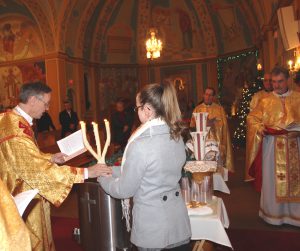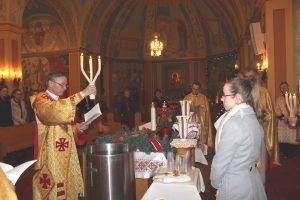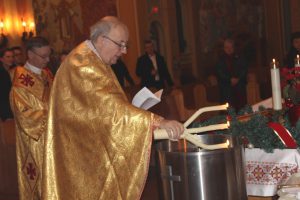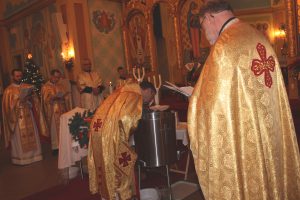Story and photos by Jayne L. Buryn, Communications Coordinator, Ukrainian Catholic Eparchy of Edmonton
January 25, 2018: During the feast of Theophany, the Ukrainian Catholic Church celebrates Christ’s baptism by St. John the Baptist on the Jordan River. As in a number of parishes in the Eparchy, on January 5th, Theophany Eve, the traditional water blessing was held at St. Josaphat’s Cathedral according to Ukrainian Catholic Church tradition.
The evening began with the Schedryj Vechir meal, shared by the community, followed by the Divine Liturgy, concelebrated by Bishop David Motiuk and a number of Eparchial priests, and the Great Water-blessing.
After the Liturgy, the water blessing service began. It was a special day for Rev. Michael Kowalchyk whose granddaughters, Kristine, Larissa and Victoria, daughters of Andrew and Wanda Kowalchyk, participated with him in the ceremony.
The Water Blessing Service: What does it all mean?

 At Christ’s baptism, the Trinity (Father, Son and Holy Spirit) was revealed. A lighted triple candle (Trojka) reminds the faithful of that mystical manifestation. The Ektenia of Peace with special petitions is recited here, asking God, through the Holy Spirit to sanctify the water to bring to the faithful and their homes the blessing of the Jordan, defend them from the devil, heal spiritual and physical ills and bestow on them the graces of the Third Person of the Trinity.
At Christ’s baptism, the Trinity (Father, Son and Holy Spirit) was revealed. A lighted triple candle (Trojka) reminds the faithful of that mystical manifestation. The Ektenia of Peace with special petitions is recited here, asking God, through the Holy Spirit to sanctify the water to bring to the faithful and their homes the blessing of the Jordan, defend them from the devil, heal spiritual and physical ills and bestow on them the graces of the Third Person of the Trinity.
The water is then consecrated and blessed with a dipping into the water, one at a time, of the three burning candles representing the Trinity. This commemorates the Lord’s baptism, when he stepped into the Jordan as the “Lamb who took away the sins of the world (Jn 1:29) by washing them away through Baptism. (Greek baptism: dipping in water, immersion.)
The celebrant then breaths the sign of the cross over the water. This symbolizes a purification, an exorcism of the contamination of the water by the influence and power of evil.
 This is followed by the celebrant making a sign of the cross three times in the water with his hand, a gesture of blessing the Jordan through Christ Himself. At this step, Christ is seen as coming to touch the waters to sanctify, heal, clean and bless everyone sprinkled or washed with, or who drinks, this water.
This is followed by the celebrant making a sign of the cross three times in the water with his hand, a gesture of blessing the Jordan through Christ Himself. At this step, Christ is seen as coming to touch the waters to sanctify, heal, clean and bless everyone sprinkled or washed with, or who drinks, this water.
The celebrant then lowers a wooden cross into the water three times, a representation of the manifestation of the Holy Trinity as Jesus Christ, the second person of the Trinity stepped out of the water.

Bishop David breaths on the water.
At the conclusion of the service, the celebrant sprinkles the altar, the walls of the church and the faithful with the blessed water, a symbol of the blessing of the Jordan and a sign of redemption. The faithful approach the Holy Water receptacle to kiss the Holy Cross, drink some of the Holy Water for the purification it provides, and fill containers with the freshly-blessed water to take home.
During the Theophany period, priests bless the homes of their parishioners. This tradition, performed annually, calls upon God to bless and protect the property and the persons occupying it. It is serves to refresh the home from the tainting of the sins of those living in it, similarly to a regular cleansing of our bodies with water and souls with confession.
http://www.liturgies.net/Epiphany/Baptism/water.htm



Recent Comments